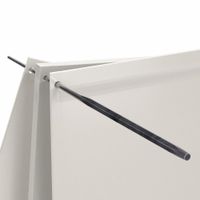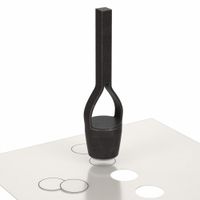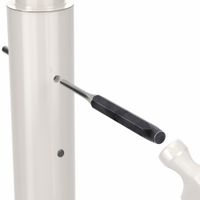Call +(254) 703 030 000 / 751 483 999 / 721 704 777
- Home
- Tools
- Hand Tools
- Punching Tools Chisels
- Punches Sets
.....Read More
Frequently Asked Questions
What are the different types of punches used in metalworking?
In metalworking, punches are tools used to create holes or indentations in metal. The different types of punches include:
1. **Center Punch**: Used to mark the center of a point, typically for drilling. It creates a small dimple to guide the drill bit.
2. **Prick Punch**: Similar to a center punch but with a sharper point, used for more precise marking.
3. **Drift Punch**: Used to align holes by inserting it into the hole and moving the metal pieces until they are aligned.
4. **Pin Punch**: Designed to drive out pins or rivets from holes. It has a straight shank and a flat tip.
5. **Transfer Punch**: Used to transfer the location of holes through a template onto a workpiece.
6. **Pilot Punch**: Used to drive out pins or rivets that are already loosened, featuring a long, narrow shank.
7. **Hollow Punch**: Used to create holes in softer materials like leather or rubber, featuring a sharp, hollow end.
8. **Chassis Punch**: Also known as a knockout punch, used to create large holes in sheet metal, often for electrical or plumbing work.
9. **Letter and Number Punch**: Used to imprint letters or numbers onto metal surfaces for identification or labeling.
10. **Round Punch**: Used to create round holes, often in conjunction with a die.
11. **Square Punch**: Used to create square holes, typically in sheet metal.
12. **Rectangular Punch**: Used to create rectangular holes, often for slots or tabs.
13. **Dimple Punch**: Used to create a dimple in sheet metal, often for decorative purposes or to strengthen the material.
Each type of punch is designed for specific applications, ensuring precision and efficiency in metalworking tasks.
How do you properly use a center punch?
To properly use a center punch, follow these steps:
1. **Select the Right Punch**: Choose a center punch with a tip angle suitable for your material. A 60-degree tip is common for metal, while a sharper angle may be better for softer materials.
2. **Mark the Spot**: Use a ruler or measuring tool to determine the exact location where you need to make the indentation. Mark this spot with a pencil or marker for accuracy.
3. **Secure the Material**: Place the material on a stable surface. If possible, use a vise or clamps to hold it in place to prevent movement during punching.
4. **Position the Punch**: Align the tip of the center punch with the marked spot. Hold the punch vertically to ensure a straight indentation.
5. **Grip the Punch**: Hold the punch firmly with one hand, ensuring your fingers are away from the striking end to avoid injury.
6. **Strike the Punch**: Use a hammer to strike the top of the punch. A single, firm blow is usually sufficient. The force should be enough to create a visible indentation but not so hard as to damage the material or the punch.
7. **Check the Indentation**: Inspect the indentation to ensure it is centered and deep enough to guide a drill bit. If necessary, reposition the punch and strike again.
8. **Drill the Hole**: Use the indentation as a guide to start drilling. The indentation helps prevent the drill bit from wandering.
9. **Clean Up**: After use, clean the punch and store it properly to maintain its condition.
By following these steps, you ensure precision and safety when using a center punch.
What materials can hand punches work with?
Hand punches can work with a variety of materials, depending on the design and strength of the punch. Common materials include:
1. **Paper**: Hand punches are frequently used for creating holes in paper for binding or decorative purposes. They are ideal for office, school, and craft projects.
2. **Cardstock**: Thicker than regular paper, cardstock can also be punched with hand punches, making it suitable for scrapbooking, card making, and other crafts.
3. **Leather**: Specialized leather punches are designed to create holes in leather for belts, bags, and other leather goods. These punches are typically more robust to handle the material's toughness.
4. **Fabric**: Some hand punches can be used on fabric, especially for creating holes for eyelets or decorative purposes. However, the fabric may need to be stabilized with interfacing or similar materials to ensure clean cuts.
5. **Thin Metal Sheets**: Certain heavy-duty hand punches can work with thin metal sheets, such as aluminum or brass, often used in jewelry making or metal crafts.
6. **Plastic**: Hand punches can be used on thin plastic sheets, such as those used in report covers or craft projects. The punch must be sharp and sturdy to handle the material without cracking it.
7. **Rubber**: Some punches are designed to work with rubber materials, often used in crafting or industrial applications.
8. **Foam**: Craft punches can be used on foam sheets for various creative projects, though the thickness of the foam may affect the punch's effectiveness.
The effectiveness of a hand punch on these materials depends on the punch's design, sharpness, and the material's thickness and density.
How do you maintain and care for punches?
To maintain and care for punches, follow these steps:
1. **Cleaning**: Regularly clean punches to remove debris and residue. Use a soft brush or compressed air to clear out any particles. For stubborn residues, use a mild solvent or cleaning solution.
2. **Lubrication**: Apply a light machine oil or a specialized punch lubricant to moving parts to reduce friction and wear. Ensure that the lubricant is compatible with the punch material.
3. **Inspection**: Frequently inspect punches for signs of wear, such as dull edges, chips, or cracks. Early detection of wear can prevent further damage and ensure consistent performance.
4. **Sharpening**: Sharpen punches when they become dull. Use a sharpening stone or a professional sharpening service to maintain the cutting edge. Ensure the angle and shape are consistent with the original design.
5. **Storage**: Store punches in a dry, clean environment to prevent rust and corrosion. Use protective covers or cases to avoid physical damage.
6. **Handling**: Handle punches with care to prevent dropping or mishandling, which can cause damage. Use appropriate tools and techniques when installing or removing punches.
7. **Calibration**: Regularly calibrate punches to ensure they are aligned and functioning correctly. Misalignment can lead to uneven wear and poor performance.
8. **Replacement**: Replace punches when they show significant wear or damage that cannot be repaired. Using worn-out punches can compromise the quality of work and damage materials.
9. **Training**: Ensure that all operators are trained in the proper use and maintenance of punches to prevent misuse and extend their lifespan.
By following these steps, you can ensure that punches remain in good condition, providing reliable and precise performance over time.
What safety precautions should be taken when using punches?
1. **Wear Personal Protective Equipment (PPE):** Use safety goggles to protect your eyes from flying debris. Wear gloves to protect your hands from sharp edges and vibrations.
2. **Inspect Tools Before Use:** Check punches for any signs of wear, cracks, or damage. Ensure the punch is clean and free from oil or grease to prevent slipping.
3. **Use the Right Punch for the Job:** Select the appropriate type and size of punch for the material and task to avoid tool damage and ensure precision.
4. **Secure the Workpiece:** Ensure the material being punched is securely clamped or held in place to prevent movement during the operation.
5. **Use a Proper Striking Tool:** Use a hammer or mallet that is appropriate for the punch size. Avoid using a hammer that is too heavy or too light.
6. **Maintain Proper Posture and Grip:** Stand in a balanced position and hold the punch firmly to maintain control and prevent slipping.
7. **Keep Hands Clear:** Ensure your hands and fingers are clear of the striking area to avoid injury.
8. **Work in a Well-Lit Area:** Ensure adequate lighting to clearly see the workpiece and punch alignment.
9. **Avoid Distractions:** Focus on the task at hand to prevent accidents caused by inattention.
10. **Store Tools Properly:** After use, clean and store punches in a dry, organized place to prevent rust and damage.
11. **Regular Maintenance:** Sharpen and maintain punches regularly to ensure they are in good working condition.
12. **Follow Manufacturer’s Instructions:** Adhere to any specific guidelines provided by the manufacturer for safe and effective use.
How do you choose the right punch for a specific application?
To choose the right punch for a specific application, consider the following factors:
1. **Material Type and Thickness**: Determine the material you are working with (e.g., metal, plastic, paper) and its thickness. This will influence the punch material and design, as harder materials require more robust punches.
2. **Punch Material**: Select a punch material that can withstand the application demands. Common materials include tool steel, high-speed steel, and carbide. Tool steel is suitable for general applications, while carbide is ideal for high-volume or abrasive materials.
3. **Punch Shape and Size**: Choose the punch shape (round, square, oblong, etc.) and size based on the desired hole shape and dimensions. Ensure the punch size matches the die size to maintain precision and avoid damage.
4. **Punch Coating**: Consider coatings like titanium nitride (TiN) or titanium carbonitride (TiCN) to enhance punch durability and reduce friction, especially in high-speed or high-wear applications.
5. **Clearance**: Ensure proper clearance between the punch and die to prevent material tearing and ensure clean cuts. Clearance depends on material type and thickness.
6. **Press Type and Capacity**: Match the punch to the press type (mechanical, hydraulic, etc.) and its capacity. Ensure the press can handle the punch force required for the material and thickness.
7. **Production Volume**: For high-volume production, select punches with longer life and durability to minimize downtime and replacement costs.
8. **Maintenance and Replacement**: Consider ease of maintenance and availability of replacement parts. Opt for punches that are easy to sharpen or replace to reduce operational downtime.
9. **Cost**: Balance cost with performance requirements. Higher initial costs for durable punches may lead to long-term savings in high-volume applications.
By evaluating these factors, you can select a punch that meets the specific needs of your application, ensuring efficiency and quality in the punching process.
What are the common problems encountered when using punches and how can they be resolved?
Common problems with punches include:
1. **Misalignment**: Punches may not align properly with the die, causing uneven cuts or damage.
- **Resolution**: Regularly calibrate and maintain equipment to ensure proper alignment.
2. **Wear and Tear**: Frequent use can dull punches, leading to poor-quality cuts.
- **Resolution**: Implement a routine sharpening schedule and use high-quality materials to extend tool life.
3. **Chipping and Breakage**: Excessive force or improper material can cause punches to chip or break.
- **Resolution**: Use appropriate materials and ensure correct punch-to-die clearance to reduce stress.
4. **Material Jamming**: Material can get stuck in the die, causing interruptions.
- **Resolution**: Use lubricants and ensure proper clearance to facilitate smooth operation.
5. **Burr Formation**: Rough edges or burrs can form on the material.
- **Resolution**: Adjust punch speed and angle, and ensure sharpness to minimize burrs.
6. **Punching Force Issues**: Insufficient or excessive force can lead to incomplete cuts or tool damage.
- **Resolution**: Calibrate machines to apply the correct force for the material being punched.
7. **Tooling Setup Errors**: Incorrect setup can lead to operational inefficiencies.
- **Resolution**: Train operators thoroughly and use setup guides to ensure correct tooling.
8. **Heat Generation**: Excessive heat can cause tool deformation.
- **Resolution**: Use cooling systems and appropriate punch speeds to manage heat.
9. **Material Deformation**: Thin or soft materials may deform during punching.
- **Resolution**: Adjust punch speed and use backing materials to support the workpiece.
10. **Noise and Vibration**: High noise levels and vibrations can affect precision and operator comfort.
- **Resolution**: Use dampening materials and maintain equipment to reduce noise and vibration.
Regular maintenance, proper training, and using the right materials and settings are key to resolving these issues.




